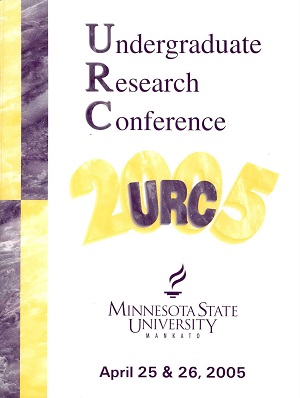Using Distance Sampling to Estimate Densities of Deer in Minnesota's Farmland Region
Location
CSU 285
Start Date
25-4-2005 10:30 AM
End Date
25-4-2005 12:00 PM
Student's Major
Biological Sciences
Student's College
Science, Engineering and Technology
Mentor's Name
Brock R. McMillian
Mentor's Department
Biological Sciences
Mentor's College
Science, Engineering and Technology
Description
Estimation of the size of the white-tailed deer (Odocoileus virginianus) population is essential for proper management of the deer herd. Further, a survey of wildlife managers indicated that improved techniques were needed to monitor deer populations in Minnesota's farmland region. We evaluated a new method, distance sampling, in an effort to identify a more accurate and efficient method of estimating the size of deer populations. Distance sampling is an increasingly popular method of estimating the size of animal populations due to its accuracy and logistical advantages relative to other methods. In this pilot study, we used distance sampling to estimate the pre- and post-hunt sizes of the deer population in Watonwan County. We compared mean distances and deer-group sizes between seasons and within habitats, and also estimated densities of deer using DISTANCE software. To evaluate distance sampling, 24 spotlight surveys were conducted from 18 October-28 December 2004. We observed 537 deer during 12 surveys in the pre-hunt period and 620 deer during 12 surveys in the post-hunt period. Preliminary analyses indicated that mean deer-group sizes differed (P<0.001) between seasons (mean pre-season = 2.1 deer/group [SE = 0.1], mean postseason= 2.9 deer/group [SE = 0.2]). Average distance from deer to observer also differed (P<0.05) between seasons (pre-hunt = 128 m [SE = 5] and post-hunt = 145 m [SE = 7]). Further analysis of our findings will likely demonstrate that distance sampling will improve current techniques and, therefore, estimates of,the size of white-tailed deer populations utilized by the Minnesota Department of Natural Resources.
Using Distance Sampling to Estimate Densities of Deer in Minnesota's Farmland Region
CSU 285
Estimation of the size of the white-tailed deer (Odocoileus virginianus) population is essential for proper management of the deer herd. Further, a survey of wildlife managers indicated that improved techniques were needed to monitor deer populations in Minnesota's farmland region. We evaluated a new method, distance sampling, in an effort to identify a more accurate and efficient method of estimating the size of deer populations. Distance sampling is an increasingly popular method of estimating the size of animal populations due to its accuracy and logistical advantages relative to other methods. In this pilot study, we used distance sampling to estimate the pre- and post-hunt sizes of the deer population in Watonwan County. We compared mean distances and deer-group sizes between seasons and within habitats, and also estimated densities of deer using DISTANCE software. To evaluate distance sampling, 24 spotlight surveys were conducted from 18 October-28 December 2004. We observed 537 deer during 12 surveys in the pre-hunt period and 620 deer during 12 surveys in the post-hunt period. Preliminary analyses indicated that mean deer-group sizes differed (P<0.001) between seasons (mean pre-season = 2.1 deer/group [SE = 0.1], mean postseason= 2.9 deer/group [SE = 0.2]). Average distance from deer to observer also differed (P<0.05) between seasons (pre-hunt = 128 m [SE = 5] and post-hunt = 145 m [SE = 7]). Further analysis of our findings will likely demonstrate that distance sampling will improve current techniques and, therefore, estimates of,the size of white-tailed deer populations utilized by the Minnesota Department of Natural Resources.
Recommended Citation
LaRue, Michelle A.. "Using Distance Sampling to Estimate Densities of Deer in Minnesota's Farmland Region." Undergraduate Research Symposium, Mankato, MN, April 25, 2005.
https://cornerstone.lib.mnsu.edu/urs/2005/oral-session-D/3



